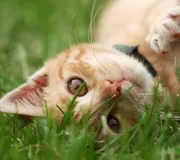Nearly half of all domesticated cats are overweight. Obesity can lead to various health issues like diabetes, heart problems, and arthritis. Find out if your cat falls into the “obese” category using these strategies from a St. Lucie County veterinarian. For information on managing obesity in other pets, see the article ‘Combating Obesity in Ferrets‘.
Feel the Body
Feel the sides of your cat. If you can feel the ribs underneath the skin and a thin layer of fat, without pressing very hard, your cat is probably in a normal weight range. If, however, you can’t feel any bones or you have to press in a lot to feel the ribs, your cat is probably too fat.
Look at the Dimensions
Stand up and look down on your cat from above. The cat’s abdomen should narrow slightly as it blends into the back hips, forming a kind of “waist.” If your cat’s abdomen just seems to connect in a straight line to the rump and tail area, she could be carrying some extra weight around.
Look at your cat from the side, on ground level. The stomach should tuck up a bit up into the back legs. If there just seems to be a straight horizontal line into your cat’s rump area, your cat might be obese.
Use a Diagram
Another useful tool for determining your cat’s weight is a diagram. These contain pictures of healthy cat body proportions for you to compare your own pet to. There are also conditioning charts and other documents that can be of use. They are available at many pet stores and veterinarian’s offices.
Visit Your Vet
Of course, the best way to determine if your cat is overweight is to visit your St. Lucie County veterinarian’s office. Here, you can get a professional opinion and diagnosis, as well as ways to start slimming your cat down should she be diagnosed as overweight. Set up an appointment to visit your vet in St. Lucie County, FL today!

